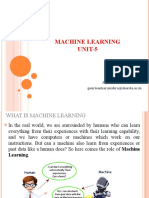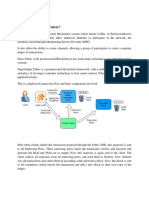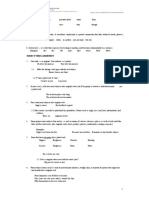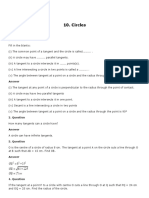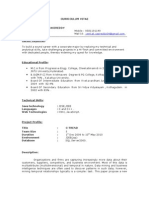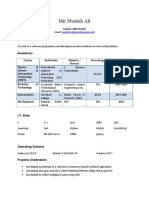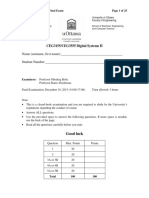MACHINE LEARNING
Er. Aarti Sharma
Associate Professor
Department : CSE
1
Traditional Algorithm Vs Machine Learning
2
3
What is Machine Learning
In the real world, humans who can learn
everything from their experiences with
their learning capability
computers or machines which work on our
instructions. But can a machine also learn
from experiences or past data like a human
does?
Machine Learning is said as a subset
of artificial intelligence that is mainly
concerned with the development of
algorithms which allow a computer to learn
from the data and past experiences on their
own.
According to Arthur Samuel in 1959
stated that
“it gives computers the ability to learn
without being explicitly programmed”.
1997, Tom Mitchell gave a “well-posed”
mathematical and relational definition that
“A computer program is said to learn 4
How does Machine Learning work
A Machine Learning system learns from historical data,
builds the prediction models, and whenever it
receives new data, predicts the output for it.
Suppose we have a complex problem, where we need to
perform some predictions, so instead of writing a code for
it, we just need to feed the data to generic algorithms, and
with the help of these algorithms, machine builds the logic
as per the data and predict the output.
5
6
Features of Machine Learning:
Machine learning uses data to detect various patterns in a
given dataset.
It can learn from past data and improve automatically.
It is a data-driven technology.
Machine learning is much similar to data mining as it also
deals with the huge amount of the data.
The importance of Machine Learning:
Rapid increment in the production of data
Solving complex problems, which are difficult for a human
Decision making in various sector including finance
Finding hidden patterns and extracting useful information
from data.
7
Types of Machine Learning
8
Applications of Machine learning
9
Machine learning Life cycle
10
Difference between Artificial intelligence and
Machine learning
AI: AI is a bigger concept to create intelligent
machines that can simulate human thinking
capability and behavior, whereas, machine
learning is an application or subset of AI that
allows machines to learn from data without being
programmed explicitly.
ML: Machine learning is a subfield of artificial
intelligence, which enables machines to learn
from past data or experiences without being
explicitly programmed.
11
Difference between Artificial intelligence and
Machine learning
12
What is Learning?
A way of making a computer to learn and act
like humans by feeding data and information
without being explicitly programmed.
Basically we can say that machine learning is
subset of AI.
There are 3 types of learning:
a) Supervised Learning
b) Unsupervised Learning
c) Reinforcement Learning
13
What is Supervised Learning?
In Supervised learning, you can teach the
machine using data which is well "labeled."
It means some data is already tagged with the
correct answer. It can be compared to learning
which takes place in the presence of a supervisor
or a teacher.
A supervised learning algorithm learns from
labeled training data, helps you to predict
outcomes for unforeseen data.
Expert Team or Data scientist are required to
successfully build supervised model. 14
What is a Labeled Data Set?
The data set with output for a given input is
called a Labeled Dataset.
For example:
15
Why Supervised Learning?
Supervised learning allows you to collect data
or produce a data output from the previous
experience.
Helps you to optimize performance criteria
using experience
Supervised learning helps you to solve various
types of real-world computation problems.
It is a fast learning mechanism with high
accuracy.
16
Problem Type?
Supervised Learning problem include:
1) Regression problem
2) Classification problem
17
Approach of Supervised Learning
18
How Supervised Learning Works?
19
For example, if you want to train a machine to
help you predict how long it will take us to
drive home from your workplace. We start by
creating a set of labeled data. This data
includes
Weather conditions
Time of the day
Holidays
All these details are our inputs. The output is
the amount of time it took to drive back home
on that specific day.
20
First Case: If it is raining outside, then it will
take larger time or not.
Second Case: if we get out at 6p.m to get
home will take larger time or not
21
Output feedback of Supervised Learning
22
Some Popular Algorithms of Supervised
Learning
Linear Regression
Decision Trees
K- Nearest Neighbor
Support Vector Machine
Neural Networks
23
Some Applications
Fraud Detection
Risk evaluation
Forecast sales
Loan approval or rejection
24
What is Unsupervised Learning?
In Unsupervised learning technique, you do not
need to supervise the model.
Instead, you need to allow the model to work on
its own to discover information.
It mainly deals with the unlabelled data.
Unsupervised learning algorithms allow you to
perform more complex processing tasks
compared to supervised learning.
Although, unsupervised learning can be more
unpredictable as compared to other learning
methods. 25
What is a Unlabeled Data Set?
The data set with unknown output values for
all input values is called a Unlabeled Dataset.
For example:
26
Why Unsupervised Learning?
There, are some prime reasons for using
Unsupervised Learning:
Unsupervised method finds all kind of unknown
patterns in data.
It help you to find features which can be useful for
categorization.
It is taken place in real time, so all the input data to
be analyzed and labeled in the presence of learners.
It is easier to get unlabeled data from a computer
than labeled data, which needs manual intervention.
27
Types of Unsupervised Learning Techniques
Unsupervised Learning problem further
grouped into:
1) Clustering .
Eg. Telecom company
2) Association.
Eg. Supper Market
28
Approach of Unsupervised Learning
29
How Unsupervised Learning Works?
Let's, take the case of a baby and her family
dog.
A new dog:
30
Output feedback of
Unsupervised Learning
31
Some Unsupervised Learning Algorithms
Unsupervised algorithms can be divided into
different categories like:
Cluster algorithms,
K-means clustering,
Hierarchical clustering,
Apriori Algorithm etc.
32
Some Applications Areas
• Recommendation system
• Anomaly detection
• Market Basket Analysis, …etc
33
Classification of Machine Learning
34
35
THANK YOU !
36


